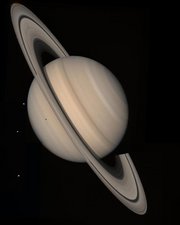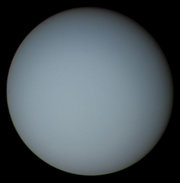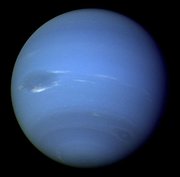Voyager 2
|
|
Voyager.jpg
The Voyager 2 spacecraft was launched in 1977, originally planned as Mariner 12 of the Mariner program. It is identical to its sister Voyager program craft, Voyager 1 (a.k.a. Mariner 11). Voyager 2 followed a somewhat different trajectory during its Saturn encounter, however, bypassing a close encounter with Titan in favour of taking advantage of a gravitational slingshot to travel on to Uranus and Neptune. It became the first and so far only probe to visit those two planets and the first spacecraft to make the Grand Tour of Jupiter, Saturn, Uranus and Neptune due to a rare geometric arrangement of those four planets that only occurs once every 175 years[2] (http://voyager.jpl.nasa.gov/science/planetary.html).
For details on the Voyager instrument packages, see the separate article on the Voyager program.
PIA01480_Voyager2Launch-NASA.jpg
| Contents |
Mission planning and launch
Voyager 2 was launched on August 20, 1977, from Cape Canaveral, Florida aboard a Titan IIIE Centaur rocket.
When ground crews became engrossed in a launch problem with Voyager 1, they forgot to send an important activation code to Voyager 2. This caused the probe to shut down its main high-gain antenna. Ground crews were able to establish contact through its low-gain antenna and reactivate it.
Jupiter
The closest approach to Jupiter occurred on July 9, 1979.
Saturn
The closest approach to Saturn occurred on August 25, 1981.While behind Saturn (as viewed from Earth), Voyager 2 probed Saturn's upper atmosphere with its radar, to measure temperature and density profiles. Voyager 2 found that at the highest levels (70 Millibars) Saturn's temperature was 70 kelvins, while at the deepest levels measured (1200 Millibars) the temperature increased to 143 kelvins. The North pole was found to be 10 kelvins cooler, although this may be seasonal (see also Saturn Oppositions).
Uranus
The closest approach to Uranus occurred on January 24, 1986.Voyager 2 discovered 10 previously unknown moons, studied its unique atmosphere (Uranus has an Axial tilt of 97.77°), and its ring system.
Neptune
The closest approach to Neptune occurred on August 25, 1989. Since this was the last major planet Voyager 2 could visit, it was decided to make a close flyby of Triton, regardless of the consequences to the trajectory, similar to Voyager 1 and its encounter with Saturn and its moon Titan.The probe also discovered the Great Dark Spot, which has since disappeared according to Hubble Space Telescope observations.
Escaping Solar System
As of January 11 2005, Voyager 2 was at a distance of 75.4 AU and is escaping the solar system at a speed of about 3.3 AU per year (ca. 15.6 km/s).
Voyager 2 is expected to keep on transmitting into the 2030s.
Current Voyager 2 Data Processing and Operations
There were 41.1 hours of DSN scheduled support for Voyager 2 of which 22.5 hours were large aperture coverage. There were no real-time or schedule support changes or significant outages during the period
Science instrument performance was nominal for all activities during this period. One frame of GS-4 data was recorded this week. The EDR backlog is 2 days.
Voyager 2 command operations consisted of the uplink of seven bracketed command loss timer resets sent on five-minute centers using 1.0 Hz steps on 03/16 [DOY 075/0342z]. The spacecraft received two of the seven commands sent
This infomation is avalable from: http://voyager.jpl.nasa.gov/mission/weekly-reports/index.htm
Fiction about Voyager
The motion picture Starman portrayed Voyager 2 as having been located by an alien intelligence who subsequently sent one of their own race to investigate intelligent life on Earth.
Although only two Voyagers were launched (as of 2005), Star Trek: The Motion Picture references a "Voyager 6" which disappears into a black hole and emerges on the far side of the galaxy.
In the television series Star Trek: Voyager the starship the crew travels on is named for the Voyager space probes. In this series, due to his senility (Dr. Lewis Zimmerman) wrongfully mentions Voyager as Pioneer. This is an attempt at humor since both the Pioneer 10 and Pioneer 11 space probes shared the same fate as the Voyager 1 and Voyager 2 space probes. The Pathfinder project in the same episode probably references NASA's Pathfinder project.
See also
- Voyager program for more information about this spacecraft.
External links
- NASA Voyager website (http://voyager.jpl.nasa.gov)
- Voyager Spacecraft Lifetime (http://voyager.jpl.nasa.gov/spacecraft/spacecraftlife.html)
- Spacecraft Escaping the Solar System (http://www.heavens-above.com/solar-escape.asp) - current positions and diagrams
- Mission state (http://voyager.jpl.nasa.gov/mission/weekly-reports/)
References
Template:Web reference Template:Web referencede:Voyager 2 es:Voyager 2 he:וויאג'ר 2 it:Voyager 2 nl:Voyager 2 pl:Voyager 2 pt:Voyager 2 fi:Voyager 2 sv:Voyager 2 zh:旅行者2号
Categories: Jupiter | Saturn | Uranus | Neptune | NASA probes



